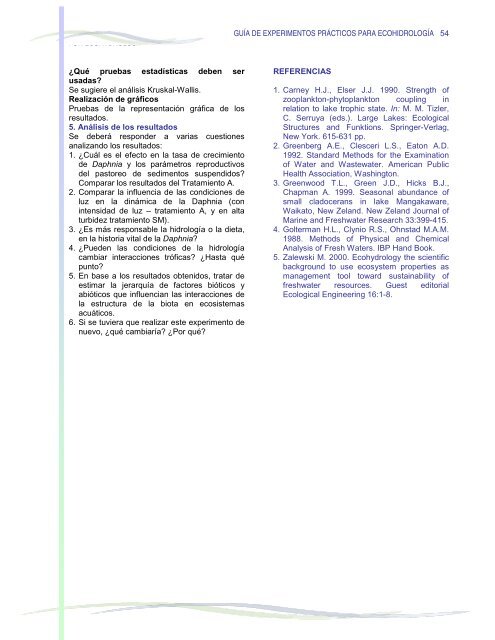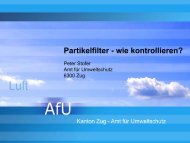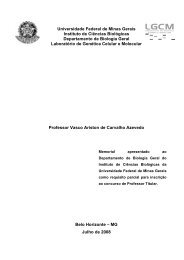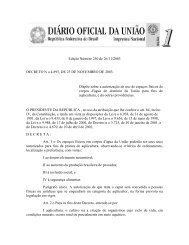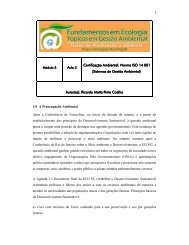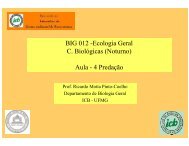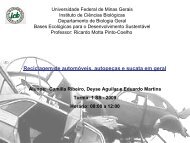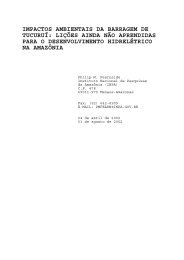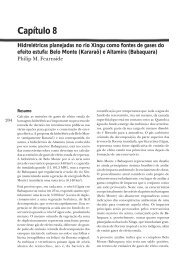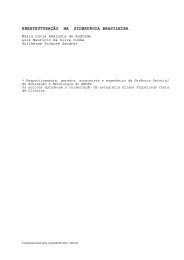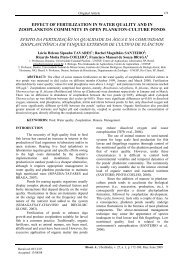guía práctica de experimentos para - Ecologia e Gestão Ambiental
guía práctica de experimentos para - Ecologia e Gestão Ambiental
guía práctica de experimentos para - Ecologia e Gestão Ambiental
You also want an ePaper? Increase the reach of your titles
YUMPU automatically turns print PDFs into web optimized ePapers that Google loves.
FOR ECOHYDROLOGY<br />
¿Qué pruebas estadísticas <strong>de</strong>ben ser<br />
usadas?<br />
Se sugiere el análisis Kruskal-Wallis.<br />
Realización <strong>de</strong> gráficos<br />
Pruebas <strong>de</strong> la representación gráfica <strong>de</strong> los<br />
resultados.<br />
5. Análisis <strong>de</strong> los resultados<br />
Se <strong>de</strong>berá respon<strong>de</strong>r a varias cuestiones<br />
analizando los resultados:<br />
1. ¿Cuál es el efecto en la tasa <strong>de</strong> crecimiento<br />
<strong>de</strong> Daphnia y los parámetros reproductivos<br />
<strong>de</strong>l pastoreo <strong>de</strong> sedimentos suspendidos?<br />
Com<strong>para</strong>r los resultados <strong>de</strong>l Tratamiento A.<br />
2. Com<strong>para</strong>r la influencia <strong>de</strong> las condiciones <strong>de</strong><br />
luz en la dinámica <strong>de</strong> la Daphnia (con<br />
intensidad <strong>de</strong> luz – tratamiento A, y en alta<br />
turbi<strong>de</strong>z tratamiento SM).<br />
3. ¿Es más responsable la hidrología o la dieta,<br />
en la historia vital <strong>de</strong> la Daphnia?<br />
4. ¿Pue<strong>de</strong>n las condiciones <strong>de</strong> la hidrología<br />
cambiar interacciones tróficas? ¿Hasta qué<br />
punto?<br />
5. En base a los resultados obtenidos, tratar <strong>de</strong><br />
estimar la jerarquía <strong>de</strong> factores bióticos y<br />
abióticos que influencian las interacciones <strong>de</strong><br />
la estructura <strong>de</strong> la biota en ecosistemas<br />
acuáticos.<br />
6. Si se tuviera que realizar este experimento <strong>de</strong><br />
nuevo, ¿qué cambiaría? ¿Por qué?<br />
GUÍA DE EXPERIMENTOS PRÁCTICOS PARA ECOHIDROLOGÍA<br />
REFERENCIAS<br />
1. Carney H.J., Elser J.J. 1990. Strength of<br />
zooplankton-phytoplankton coupling in<br />
relation to lake trophic state. In: M. M. Tizler,<br />
C. Serruya (eds.). Large Lakes: Ecological<br />
Structures and Funktions. Springer-Verlag,<br />
New York. 615-631 pp.<br />
2. Greenberg A.E., Clesceri L.S., Eaton A.D.<br />
1992. Standard Methods for the Examination<br />
of Water and Wastewater. American Public<br />
Health Association, Washington.<br />
3. Greenwood T.L., Green J.D., Hicks B.J.,<br />
Chapman A. 1999. Seasonal abundance of<br />
small cladocerans in lake Mangakaware,<br />
Waikato, New Zeland. New Zeland Journal of<br />
Marine and Freshwater Research 33:399-415.<br />
4. Golterman H.L., Clynio R.S., Ohnstad M.A.M.<br />
1988. Methods of Physical and Chemical<br />
Analysis of Fresh Waters. IBP Hand Book.<br />
5. Zalewski M. 2000. Ecohydrology the scientific<br />
background to use ecosystem properties as<br />
management tool toward sustainability of<br />
freshwater resources. Guest editorial<br />
Ecological Engineering 16:1-8.<br />
54


